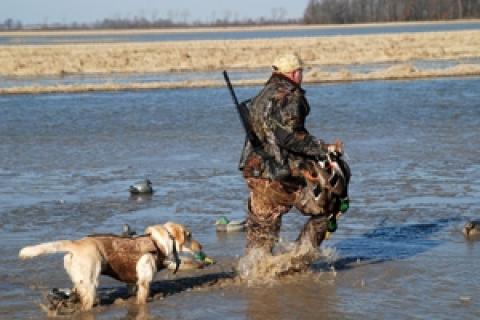
 |
| The Delta region of southeast Missouri is home to thousands of acres of rice fields, many of which are flooded for waterfowl season. |
Scott Downing blew a truly southern style highball call to a scant flock of greenhead mallards passing high over our well concealed pit blind. Downing is the superintendent of schools in the Swampeast Missouri town of East Prairie. His honorable intentions at the moment included giving some wild mallards a serious education.
I graduated from high school in the quaint little Mississippi County town in 1967. Vietnam chewed up a lot of graduates at the time, but I stalled the trip by a few years while pursuing an education in the outdoor recreation and writing field. My wife, Dian, and I found ourselves back in East Prairie at the invite of Mrs. Silvey Jones, the Director of the East Prairie Tourism Council. I had been gone for 40 years.
The Missouri Bootheel Region is a part of the old south. Every hunting lodge and waterfowl hunting operation is undergirded by good, old fashioned southern hospitality. A hearty handshake and a grand welcome awaits anyone venturing to one of Ms. Silvey's recommended adventures.
Mississippi County and the surrounding Delta counties have long been heavily farmed. Remnants of the tupelo-cypress swamps that once covered the vast Mississippi River floodplain are few these days, having been cleared from the fertile soils. The Missouri Department of Conservation established Ten Mile Pond Conservation Area in 1982 five miles south of East Prairie. Management of the 3,755 acres is devoted primarily to waterfowl. Small stands of cypress and tupelo still stand amidst the renovated marshes and agricultural fields.
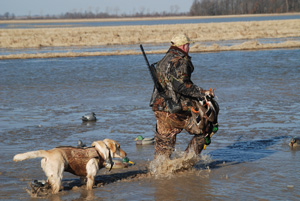 |
| Scott Downing and Avery pick up a couple of greenheads. |
"Tens of thousands of ducks and geese use Ten Mile every year," said Steve Jones, owner of Second Chance Hunt Club. "Birds roost, loaf and feed in the refuge, but waterfowl hunting is allowed in selected areas. Lots of birds fly out to feed on area farms, too."
Jones is a lifelong resident of the area and much has changed in his tenure. "Farms have grown larger as families moved away for other jobs," he continued. "Cotton has given way to soybeans, corn and rice. And weather patterns have changed as well."
The combination of socio-economic, agricultural and climatic factors Jones mentioned has been the perfect recipe for an evolving waterfowl hunting Mecca in the delta region of Missouri.
"The change in agriculture and weather in the last 30 years have been two big factors contributing to the change in waterfowl using this region," Jones said. "We see very few Canada geese anymore. The weather seldom gets cold enough long enough to push them down. On the other hand, snow geese have come on the scene in a grand fashion. They arrive here by the hundreds of thousands during both their migrations north and south. Too, the area is a duck hunting heaven. We are right in the middle of the Mississippi flyway and we get covered up with mallards by mid-December."
The Delta Region lies within the border of the south zone in Missouri. Waterfowl season generally begins in late November and runs to the end of January, giving northern hunters an opportunity to extend their waterfowl hunting seasons. And the Conservation Order for light geese begins in late January and runs through April.
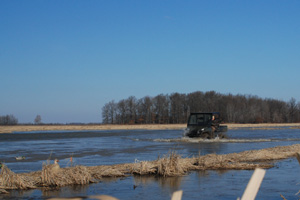 |
| Driving an ATV through your setup is a good way to keep water open for approaching ducks when temperatures are below freezing. |
Word of the superb waterfowl hunting opportunities at Ten Mile Pond Conservation Area spread rapidly. Soon there were more hunters being turned away from the morning draw for hunting spots than there were being allowed to hunt. Hunters began looking for other opportunities in the area.
"I have maintained blinds for family use for a long time," Jones quipped. "After Ten Mile became so popular, hunters searched plat books and contacted farm agencies to find out who owned prime waterfowl hunting properties. I had so many people wanting to hunt that I began sinking pits."
Extra farm income is always welcome. "Then I had a group of hunters from Georgia that wanted to rent one of my machine sheds to stay in," Jones said with a smile. "My wife suggested we turn it into a lodge. It has worked great."
The lodge creates a rustic, laid back atmosphere that any duck hunter would enjoy. In fact, every duck hunter would like to have his home decorated like Second Chance Lodge -- pintails, mallards and teal on the walls, favorite Lab paintings, a 4-inch thick slab of pine with the bark on bar, a pool table, TV and a heavily stocked kitchen. Bed and bath come with the deal, too.
Amenities are important, but waterfowl hunters want to see ducks. Second Chance has numerous pits buried in several hundred acres of flooded rice fields. "We plan to have more pits and fields by next season," Jones said. "The response to our business has been very good."
Scott Downing guides for Jones part time. "I love duck hunting," Downing remarked. "And I love to be with other people who enjoy the sport. It is a tremendous stress reliever to spend a day in the pit to watch the sunrise, watch the birds fly and relax. Taking a few birds is a bonus. We get our share of bonuses, too."
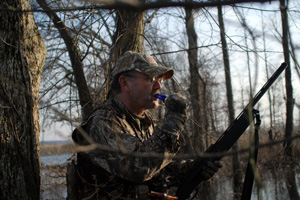 |
| Duck hunting in green timber and flooded or dry cornfields is also available in the Delta region of Missouri. |
Downing's love for duck hunting permeated everything he did while guiding Dian and me. An expert outdoorsman, he provided us an education by sharing his knowledge of area history, agricultural practices, hunting and dog handling techniques and duck identification.
Downing charmed the flight of mallards into circling for a closer look. They lost altitude quickly as they banked south and turned into the north wind. "Coming your way, Bill," Downing whispered.
I have hunted ducks for thirty years, but my pounding heart coupled with the lump in my throat made me tighten my grip on my Stoeger 12-gauge. I peered through the grass which covered the blind, but could scarcely see.
"One greenhead on your end, Bill. "Shoot him," Downing instructed.
The grass covered panel flipped forward with a slight nudge. I was awestruck by the sight in front of me. A fat mallard drake hung in the stiff wind, hovering 20-feet above the decoy set. I felt the recoil from the Winchester Extended Range load of number 2's. The mallard never knew what hit him.
The cold, clear, bluebird skies of January held ducks in any direction we looked. Funnels of ducks continued to pour into the surrounding rice fields all day. The experience of seeing so many mallards in one place was a treat in and of itself.
Downing cut loose on his call again, breathing a running commentary in between calls about what the ducks were doing. A sharp north wind whipped down the water lane in the rice. "They are swinging to the south, just like they should," he instructed. "Get ready." I swallowed hard. The excitement of the moment had my heart thump wildly. "Take 'em!"
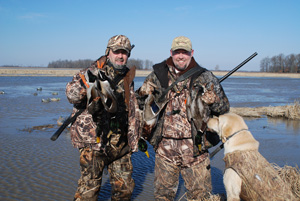 |
| Author Bill Cooper (left) and guide Scott Downing, along with retriever Avery, pose with their bounty of mallards from a cold days hunt in the rice fields of the Mississippi River delta in Missouri. |
All three of us flipped the grass covered panels of the blind back to see a trio of greenheads hovering in the stiff wind just 20 yards out. At the report of our guns, all three birds plopped into the icy water. Avery bailed out of the blind for the recovery. "I think I just killed my first mallard drake," Dian said with a giggle and a shiver.
Dian and I spent the remainder of the bitter-cold day in the blind with Downing, other than a two hour lunch and nap break. We continually broke ice in the flooded rice field to keep the area open for landing ducks. We witnessed thousands of ducks coming and going from the fields, most of which were mallards. Pintails proved plentiful, but we couldn't coax one into gun range. However, we all harvested ducks, a total of twelve for the day, a very productive day in any duck hunter's book.
After we returned to Second Chance Lodge, Dian reminisced about the day. "Wasn't Avery (Downing's yellow Lab) amazing?" Amazing indeed. Avery demonstrated his skills and made his master proud by completing a 100-yard retrieve of a downed mallard. Witnessing master and dog working together in perfect unison etched a scene in our hearts and minds that will grace our waterfowling memories for decades to come. And the grand thing about waterfowling in the Missouri Delta region is that opportunities abound for hunting in flooded corn, dry fields and green timber as well. But, those are another story.
- 6311 views

